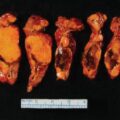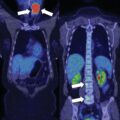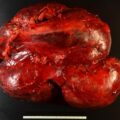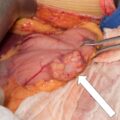##
Management of corticotropin (ACTH)-independent hypercortisolism in patients with bilateral adrenal nodules depends on imaging findings (adenomas versus macronodular hyperplasia) and tumor size. Adrenal venous sampling (AVS) is useful in patients with bilateral adrenal adenomas of similar size to guide surgical management.
Case Report
A 45-year-old woman presented for evaluation of self-diagnosed Cushing syndrome (CS). Over the prior 2 years, she progressively gained weight with abdominal fat redistribution, developed striae over her abdomen, supraclavicular and dorsocervical fat pads, hair loss, mood swings, anxiety, depression, insomnia, and signs of proximal myopathy (that she noticed on climbing up the stairs). She had also noticed facial rounding and erythema. Despite working out in the gym, she was unable to lose weight. In addition, she reported a new-onset hypertension and a new-onset diabetes mellitus type 2 (hemoglobin A1C, 6.7%) diagnosed 6 months previously. Medications included lisinopril, hydrochlorothiazide, and metformin. The patient researched her constellation of symptoms and suspected CS. Further workup at home confirmed hypercortisolism. On physical examination, her blood pressure was 172/105 mmHg and body mass index was 34.2 kg/m 2 . She had abdominal striae, facial rounding and erythema, dorsocervical pad, and supraclavicular pads.
INVESTIGATIONS
After confirmation of ACTH-independent hypercortisolism ( Table 18.1 ), abdominal imaging was obtained. Abdominal computed tomography demonstrated bilateral adrenal nodules, 2.6 cm on the right and 2.8 cm on the left ( Fig. 18.1 ). As imaging phenotype was not consistent with bilateral macronodular hyperplasia, AVS was performed to identify the source of autonomous cortisol secretion. In preparation for the AVS procedure, dexamethasone 0.5 mg was initiated on the morning the day prior, and every 6 hours, including the morning of AVS. Cosyntropin (which is commonly infused during AVS in patients with primary aldosteronism) was not administered. Concentrations of cortisol and epinephrine were measured in inferior vena cava (IVC) and both adrenal veins ( Box 18.1 ). Based on the left adrenal vein-to-IVC cortisol ratio of 17.2 and the left adrenal vein to right adrenal vein cortisol ratio of 3.9, ACTH-independent hypercortisolism due to the dominant left adrenal adenoma was diagnosed, and left adrenalectomy was recommended. However, the patient was advised that she may continue to demonstrate a mild autonomous cortisol secretion from the right adrenal adenoma, given the right adrenal vein to inferior vena cava ratio of 4.4 (see Box 18.1 ).
| Biochemical Test | Result | Reference Range |
| Morning cortisol, mcg/dL | 22 | 7–25 |
| ACTH, pg/mL | <5 | 7.2–63 |
| DHEA-S, mcg/dL | <15 | 18–284 |
| Aldosterone, ng/dL | 4 | <21 |
| Plasma renin activity, ng/mL per hour | <0.6 | 2.9–10.8 |
| Plasma metanephrine, nmol/L | 0.21 | <0.5 |
| Plasma normetanephrine, nmol/L | 0.6 | <0.9 |
| Urine free cortisol, mcg/24 h | 373 | 3.5–45 |
Stay updated, free articles. Join our Telegram channel

Full access? Get Clinical Tree








